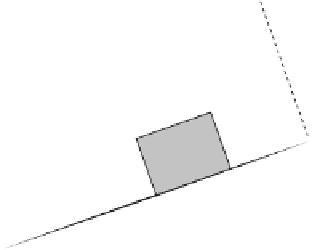Biomedical Engineering Reference
In-Depth Information
N
d
F
A
W
x
h
W
y
W
Fig. 5.12
Illustration of an inclined plane at angle
, ramp length
d
, and height
h
. The weight force
W
of the object, the component of the weight force
W
X
parallel to the plane, the component
W
Y
of weight force perpendicular to the plane, the support force
N
normal to the surface, and the
magnitude of the action force
F
A
θ
W
X
required to establish the static equilibrium of the object on
the inclined plane are shown in the diagram
¼
The force of friction performs work contrary to the movement, and the action force
has to be larger than in the ideal case without friction. However, this does not
reduce the mechanical advantage very much.
Analyzing the diagram of forces in Fig.
5.12
, we can establish for the situation
without friction that:
The magnitude of the action force is given by:
F
A
¼
W
x
¼
W
sin
θ
W
d
Thus, the mechanical advantage is given by: MA
h
As sin
θ ¼
d
, we can write:
F
A
¼
F
R
d
h
The expression for the mechanical advantage can be also obtained by using the
fact that the work done by the resistance force is equal to the work done by the
action force, without friction:
Wd
¼
F
A
¼
Wh
¼
F
A
d
Exercise 5.14
In hospitals, in the street and in public places, it is important to
have access ramps for physically disabled persons so that they may move in wheel
chairs by themselves or with help. In such a situation find the force necessary to
maintain a person in a wheelchair on a ramp one meter long with a rise of 0.2 m
when the total weight of the person and the wheelchair is 800 N (neglect friction).
What is the mechanical advantage of this inclined plane?
τ ¼
F
R
h
¼
Exercise 5.15
The figures (a), (b), and (c) of exercise 5.15 represent situations in
which simple machines based on pulleys, wheels or inclined planes are employed.
Determine for each figure the action force and the mechanical advantage of the
system.







































